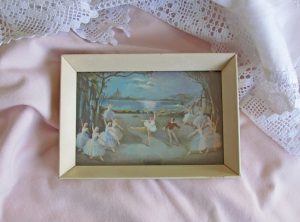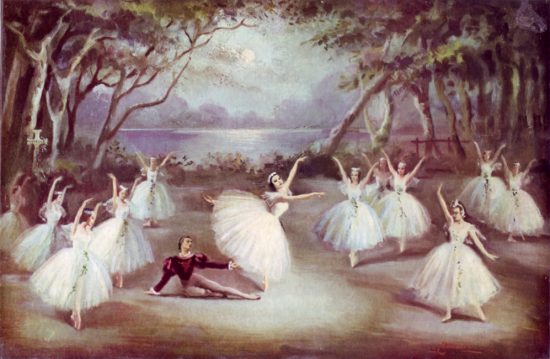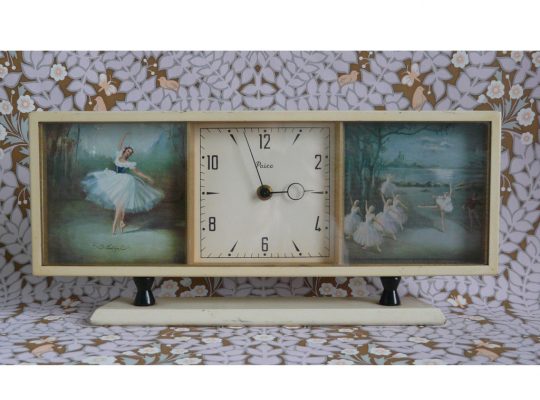And Who is Carlotta?
It’s a funny business, house-hunting. There I was, standing in the hallway of a perfect stranger’s home. I should have been admiring the art-deco stuccowork, dissecting the designer kitchen. I should’ve been nervous about the grunt of semi-trailers hurtling past the door.
But instead, I was disappearing into a world of dainty ballerinas, posed in perpetual arabesques in misty scenes from the ballet classics. There was Les Sylphides in the hallway, Swan Lake in the master bedroom, Giselle in the living room with a glimpse of Balanchine’s La Valse nearby. I imagine you’ve seen the pictures too, these little vignettes of powder puff femininity. They’re leftovers of the great British ballet boom, reproduced en mass as postcards, jigsaws and greeting cards. There’s even a mantle clock for the vintage connoisseur.
I like to think that these chocolate-box treasures were once every girl’s answer to Uncle Charlie’s Green Lady hanging in the sleepout. Today, they’re the fodder of op-shops and ebay – and sold in sets for triple figures by the hawkers of shabby chic. Back in the ’60s, it seems Australians and New Zealanders couldn’t get enough of these pretty little showpieces. Small, medium and large, plain and silvered, the prints sold in their thousands. They brought sensual revelries and the mystery of moonlit glades into the lives of ordinary Aussies.
But there’s a deeper mystery for the inquisitive collector. It’s the conundrum of the commonplace, the story of the best-selling artist condemned to obscurity by her crimes against taste. Love them or loathe them (I sit somewhere in the middle), all these ballet prints are the work of one hand. She’s there in the margins, a little flick of red paint. Edwards. C Edwards. The exotic Carlotta Edwards.
“Exotic”, indeed, is how one relative remembered her. And exotic she seems, too, for having a most ambiguous personal history. Our artist, on her marriage certificate, is one Fernande Charlotte Felicitas Katharina Pourrier. It’s not a name that immediately tallies with the story of a “young Russian woman” brought to England by a Welsh husband, as one owner of her paintings alleged.
Look up Carlotta online and every seller of her pictures has pasted in the same account: Carlotta, ‘the daughter of the French painter, Ferdinand Pourrier’—except for that one seller who insisted on making him Francis Pouvier. An illustrious father? The lead sounds promising. Until you realise that Ferdinand Pourrier is even more obscure than his daughter.
We do know that Carlotta died in 1977. That, at least, had been confirmed, and former dancer Jennie Walton (a keen Carlotta enthusiast) accepts 1894 as the year of her birth. But what about the source that claimed Carlotta had “three generations of the theatre behind her”? And what about Carlotta’s paintings of ballerinas like Margot Fonteyn and Alicia Markova, or the great Soviet ballerina Galina Ulanova? There must be dancers who remember her, surely?
Well actually, no. Jennie Walton, who has been photographing dancers since the 1960s, has proven beyond doubt that a number of Carlotta’s pictures were painted using photos. “I was told Markova knew her,” Jennie reports, “but I questioned a lot of mainly Royal Ballet dancers who were there in the ’50s and ’60s, and not one remembered her at rehearsal or in the studio.” In fact, Jennie even suspects there is a painting by Carlotta based one of her photographs!
Carlotta, Jennie surmises, began painting ballet subjects relatively late in life. She studied art in London and was producing pictures by the 1930s. The earliest known exhibition of her work was held in a theatre club in 1947. Then, in the 1950s, Carlotta was taken on by the Medici Society, a British publishing firm that specialised in making art available to the wider public, “for the lowest price commercially possible”. Carlotta’s popularity took off.
Soon, the Birmingham-based Gwenda company was also dealing in Carlotta-ware. Her pictures of dancers adorned compacts and cigarette cases. Now, once again, Carlotta’s appeal is on the rise as these retro balletic curios come back in vogue. Strange to say, the very secret of her success may be that she didn’t always paint from real life. With their ethereal dancers and frothy tutus, Carlotta’s ballet scenes distil the essence of what so many people believe ballet to be. They may be twentieth century, but there is not a whiff of the avant garde. Nor are the images complicated by an excess of male dancers with all the sexual suspicion they aroused at the time.
Carlotta’s ballerinas are neither smiling nor grief-stricken. They display poise without passion, sincerity without sophistication. And wherever there is pink bed linen, a white dresser and a pile of motley cushions, there you will find them: dainty ballerinas frolicking on the walls – while outside the semi-trailers roll by.
With my thanks to Jennie Walton for generously sharing her research. If you know something more about Carlotta Edwards, do get in touch!




Hi was reading above and seem know a lot about C. Edwards.
I was wanting to know if she done a painting on canvas called Spring in Vienna or maybe a pastel.
I have the said item on me and have had it for 30yrs. It’s definitely not a print and I cannot find any prints of her work titled Spring in Vienna.
Was wondering how much it would be worth if original?
Thankyou for your time.
I have a “le Cynge” painting in beautiful wooden frame. I’d like to know it’s value. can only find info on the print of this particular item.
Hi Erin,
I’m afraid I can’t advise as to price. If you are really confident that you have the painted original, not a print, probably best to ask a dealer who trades in vintage and retro material. If you are in the UK you may also like to try Pimpernel Prints who lists via ebay. Happy to provide a contact email if this is of interest.
Cheers,
Caitlyn
Maybe someone reading this comment can help me. My mum has had a picture of ‘Symphonie Fastastique en couleur’ by Carlotta Edwards on her wall all of my life. It was purchased in a small art shop in London in 1963. This was before the mass produced prints of her work in the mid 60’s. Does anyone know if there was a first run of prints pre 1963 or could she actually have the original? Please help.
Hi Andy, the first step will be to inspect the surface of your mum’s picture closely to see if you can discern any surface texture. If it is a print, it is more likely to be framed behind glass and the image surface will be totally flat. If it were an original, I’d assume the textured surface of oil or acrylic would be evident. (For the interest of other readers, an image of ‘Symphonie Fantasique en coleur’ can be seen on Caroline Hamilton’s post about Carlotta here.) As I noted in my article, Carlotta was first taken on by the Medici Society in the 1950s, so if your mum bought the picture in 1963 it is mostly likely she has a print. But it never hurts to check!
My family were stationed during the second world war at a large house/estate called Whettam near Calne, Wiltshire. Carlotta Edwards and her husband were also living there and she painted my portrait. I was six years old and found it very boring as I had to change into my pink party dress and have a pink bow tied in my hair and sit for seemingly hours! She was a very nice lady with dark hair which she wore tied back in a scarf which I thought very exotic. I have the portrait still, it is very charming.
I was Carlotta Edwards’ hairdresser in Mayfair for approx 3 years, around 1968-71. A beautiful and generous person and wonderful artist. I, and then my fiance and myself, were fortunate to enjoy her hospitality and friendship over the last year of living in London, at her studio/home in St John’s Wood. When we became officially engaged, she insisted on painting a portrait of my now wife of 50 years as a wedding gift for us. We have it hanging in our house. So blessed to have known her, and apart from having a beautiful portrait we have all those wonderful memories of her. On returning home it was interesting to see that my new mother-in-law had quite a few prints of Carlotta’s hanging on her walls.
I too have what I believe to be an original work by Carlotta Edwards which depicts the ballet dancer Markova dancing. It surprises me that her original work like this is not worth more than $500-600 dollars given her work’s influence on a generation plus the more recent interest in her work.
Thanks, Phillip, for mentioning a value for Carlotta’s works. I actually get quite a lot of emails to the site from people wanting to know how much they might fetch. So if anyone else would like to comment on the dirty subject of money and prices paid, please feel free to contribute here.
I guess one issue to bear in mind with valuations is the difference between the popularity of her works and their status as works of ‘art’. They are definitely iconic pop culture pieces. But whether they constitute ‘good art’ is another matter. Or at least, a matter of personal taste!
Inevitably, too, as time passes, the feminine ideals and the image of ballet her works set forth are becoming increasingly divorced from current trends, which means a smaller market for them beyond plain ‘retro’ interest. Personally speaking, I embrace her works for their historical interest, but they don’t portray ballet in a way that I relate to strongly myself.
Where do I look to find out who holds the copyright for Carlotta Edwards artwork?
Now that, Bernadette, is a very good question. I believe the Medici Society is still operating, so you could try approaching them first: https://www.medici.co.uk/
Thanks Caitlin, that’s a good idea. I’ll contact Medici. B
I was gifted a framed painting of a church with the writing “Princeton University” and signature of Carlotta on the bottom with the year 1981. I would be interested to know who Carlotta is/was and a little more about the artist, if anyone knows.
Hello,
We have in our possesion a scalloped edged vintage mirror with Carlotta Edwards “Swan Lake” or “Giselle” not sure what the title is. I do know it is close to 100 years old.